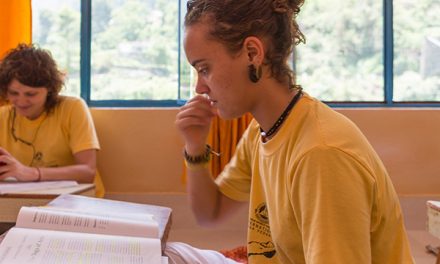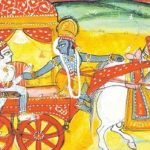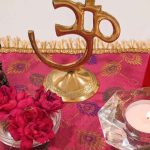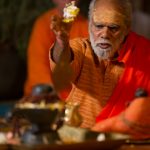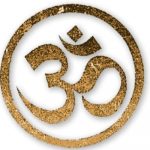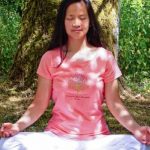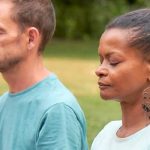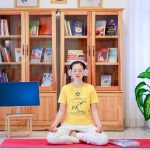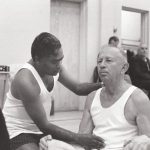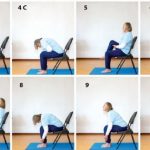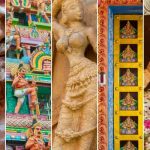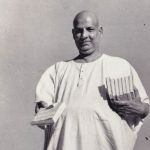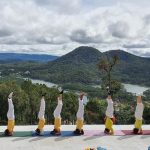 High goals – Where Yoga Can Lead Us
High goals – Where Yoga Can Lead Us
by Swami Durgananda
Expanding One’s Potential
Every human being has a potential to grow, to discover new possibilities and to unfold the layers which cover the soul. It is not only the self-realised beings who have the possibility to experience the powers of the soul on a higher plane. These possibilities are given to every human being, as soon as he or she is manifested in the body. What is wanted is an inner desire to experience more than the so-called “normal” life, which is mostly limited to self-preservation and reproduction.
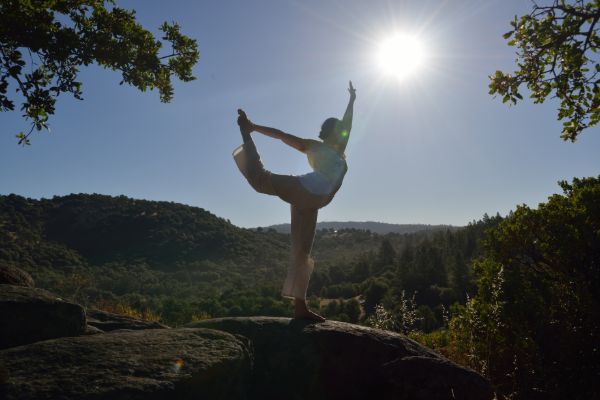 Modern science confirms that we use only a small part of the capabilities of our brain. Yoga systematically expands one’s brain capacities, and helps to avoid old automatic thought patterns and emotions even under pressure and stress.
Modern science confirms that we use only a small part of the capabilities of our brain. Yoga systematically expands one’s brain capacities, and helps to avoid old automatic thought patterns and emotions even under pressure and stress.
The Eight Steps
The essential precondition for the practice of Yoga is an ethical and moral attitude. This is presented by Patanjali Maharishi in the Raja Yoga Sutras in the form of the yamas and niyamas. One approach to raja yoga is hatha yoga which is much more than physical exercises and a bit of pranayama. A sincere and regular practice of hatha yoga develops a sensation of purity of both the body and the mind. This is enhanced by the kriyas, which literally means ‘act’ or ‘deed’.
These hatha yoga practices cleanse the physical body by outer and inner means and were developed at a time when enemas and colonics were still unknown. There was no scientific evidence on fasting and nobody had a bath tub. There were only rivers or buckets. Jala neti or nasal cleansing with salt water, is widely known today. Nauli or abdominal churning is very efficient for counteracting lethargy of the intestines due to a sedentary lifestyle. Tratak increases the power of the eyes.
All these purification techniques for the physical body are part of hatha yoga. The results cannot come in a day, the system purifies itself through regular practice. Step by step we regain control over the physical vehicle. The outcome is the experience of living and moving in a physical body, rather than being moved by it. The yogis advise us not to remain at the level of physical control and physical health, but to take the next step of hatha yoga which connects to the mental practices through pratyahara or, drawing the senses within.
This is the foundation for moving on to dharana or concentration. It is said that dharana is reached when the mind is able to focus on a specific object for 12 seconds. Dharana is the doorway to meditation or dhyana. It is said that this corresponds to keeping the mind focussed on a single object for 2½ minutes. The final step of the raja yoga system is samadhi, which is meditation without any distraction from the outer world. In this state the ego melts with super-conscious awareness and it is said that it takes about half an hour of unbroken concentration to reach this state.
The goal in hatha yoga is samadhi, the common goal of all yoga paths. Hatha yoga begins with the training of the annamaya kosha or food sheath as an important spiritual element. It is a sheath which surrounds the Atman, the soul, the divine consciousness. The next sheaths constitute the astral body. Through breath control, concentration and calming of all movements of the mind, it can be made completely quiet. This subtle astral body consists of three major functions or sheaths, which are considered upadhis or limiting adjuncts: pranamaya kosha or energy function, manomaya kosha or the function of mental perception and vijnanamaya kosha, the analysing intellect.
Purifying the Astral Body
If yoga techniques are not used to also purify the astral body, there cannot be any expansion of consciousness: everything we think or feel, any energy or emotion which we perceive is taken for real. We say, “That’s how I am“. This is tamas, the subtle lethargy of the astral body. It is subtle and on the physical level the person may be actually very flexible. Tamas can be really seen only on the astral level.
Overcoming the Thought ‘I am the body’
The various sheaths have a substantial influence on our personal condition and on our understanding. They produce a limited awareness or tunnel thinking, the kind of gross and basic thinking which needs to be overcome. Being aware that we need to transcend the gross thought of, “I am the body” is vidya, knowing that we are living under these influences and need to work with them.
This is a major step from the body to the mind and it requires time. The practice of yoga refines the senses; the way we think and perceive become clearer, the love which is inborn in us becomes purer, raga-dvesha, our likes and dislikes, are less pronounced and compassion is on the rise.
Re-occurring Obstacles
The one common obstacle is that this process requires time. There will be periods where we think: “I do not want to carry on, I am too tired, I am too old. Let me continue after retirement etc.“ Tamas or lethargy is gaining strength. Some people say, “I will practise yoga when there is less pressure in my job“. But is it not during such times of stress that yoga is the most important tool to reduce the strain on body and mind?
The Causal Plane
As our understanding and experience deepen we move into the anandamaya kosha, the causal body, where the soul has its most powerful expression. The soul, Atman, Brahman, is immaculate. The causal plane is reached in the state of samadhi as well as during deep sleep. Deep sleep is so important, because we reconnect to the powers of the soul. The dream state however does not reach the causal plane. Dreaming occurs on the astral plane.
The quality of deep sleep provides real relaxation during sleep. If the astral body is purified by the practice of hatha yoga, we spend less time dreaming. Sleeping pills do not take us to the causal body. Sometimes you may feel refreshed and ready for the day after just six hours of sleep, whereas at other times you may sleep for eight hours and wake up exhausted and groggy. Improving the quality of sleep is part of physical hygiene, of taking care of our gross instrument.
The Power of the Soul
The function of the anandamaya kosha is to give expression to the power of the soul. More than in deep sleep, this occurs during samadhi, where it is experienced in a conscious way. The ego and the mind have only a limited expression in the causal body. It is still a dualistic plane and therefore not a level of absolute self-realisation. But the various elements of the astral body find rest and for the time being there is peace.
The reality of the soul is realised as a fact, and this brings about a state of complete satisfaction. On an unconscious level we always knew about the existence of the soul. Otherwise there would not be the strong endeavour to reach that state. We know that shanti, peace, exists. It takes profound analysis and contemplation to even come to an intellectual understanding of what the three bodies and their koshas really are and how they veil the reality of the soul. Once we understand this identification with the upadhis or limiting adjuncts, we can begin to free ourselves: “This is not what I am.
These are just the vehicles of the soul. The power of the soul is what I truly am.” It is the power of the soul that can change or purify the physical and the astral body. Through practice of yoga and meditation we can experience that the senses are still present but do not drive us. We remain an observer even when we are angry or dissatisfied, when some desires have not been fulfilled. This is a tremendous step ahead and shows that a holistic development of body and mind has started.
Avidya – Ignorance
There is no problem in feeling, “I am beautiful“. The problem comes when the beauty fades. Feeling at a young age,” I am too obese” or “too ugly” is also a limitation. These perceptions are relative and could be seen quite differently in a different culture. The mind gets twisted by this kind of limited thinking, that becomes habitual. This is avidya or ignorance, the opposite of vidya or knowledge. Avidya consists of identifying with the limiting adjuncts. It is perception from the ego perspective and this is not what we are.
In general parlance‚ ‘ignorance‘ relates to outer things, not knowing, not understanding or not being able to use something. In Yoga, ignorance or avidya means not knowing who we really are. Avidya means thinking, “I am the body”. This is not difficult to comprehend intellectually, but when do we ever act accordingly in daily life? The main reason for this is that we are too involved emotionally. We get emotionally involved in thinking, “I am the body, I am male or female, I am a swami, I am a professor, I am poor, rich, tall or small, etc” and we do actually not w a n t to give up this type of ignorance.
Avidya can be reduced w i t h time, and then this kind of thinking will fade out. As soon as avidya disappears we know who we are, we know the unchanging truth, we know God. If you do not accept the word ‘God‘, you can use the words truth, Atman or Brahman. This truth is realised inside and this is the great message of yoga: we are not similar to God, we are one and the same. There is nothing higher or lower, bigger or smaller, there is only the one Self.
Brahman is Love
Bhakti yoga explains that this truth can experienced as love. This is a wonderful concept: love, God, the Self, Brahman, Atman – it is all the same. The spark of love is in every being, and it is the same spark. Thus jnana yoga declares: “The Self in you is the same Self in me and all other beings.“ It can also be called love. Love works because it is in everybody. Everybody wants to feel this love. You fall in love with a person in whom you perceive this spark.
Essentially we are love, we need love. If we are ready to selflessly give love to others, we will receive love. Yoga teaches how to share love selflessly with another. It requires an investment of discipline, patience and an unconditional attitude. Swami Vishnudevananda said: “You either become a monk or you live in a relationship. Both are difficult, as both require renunciation.“ If the Self or the love have been found within ourselves, we realise that there is no difference between me and anybody else. The science of psychology only works because we all have the same problems.
Yet we insist in seeing ourself as a unique person. That is tremendous avidya, the root out of which the evil of ‘me’ and ‘mine’ arises. It is a mistake to think, “This belongs to me“ and “I am like this“. The truth is that we are all the same. What makes the difference is the limiting factors.
Realise the Self and Be Free
When the illusions have been removed, it is called ‘direct realisation‘. The central teachings of the Upanishads declare that Brahman alone is real, the Self within, whereas all else is not real because it constantly changes. This is what is meant by realising the Self and being free. Being free does not mean that you can do what you like. Being free means being free from attachments. For example, being free from attachment to what you are doing at present and also not being unhappy when it ends.
Being really free is freedom from conditionings. It is true that we are free to do what we want, but that freedom includes having to face the consequences. If we smoke and just eat what we like, we may become sick. That means we must then also be free of attachment from our health, as our bad health is connected to our doing what we wanted to do. Freedom includes applying viveka or discrimination regarding our actions and taking responsibility for the consequences.
Accepting the Self
The experience of the Self or even a vague idea of the Self means not being in the past and future any more, but remaining increasingly in the here and now. Concentration will improve, fears will diminish and inner happiness will grow. The Upanishads declare: When you see the Self, you do not see the world. When you see the world, you do not see the Self. Why do we breathe? What makes us breathe? Is it a physiological function? Is it nature? Or is it what we call Brahman? Or God? We have to accept something that is higher then ourselves, otherwise the awareness of body and mind will be predominant and we may think it is the truth.
Freedom and Bliss
The closer you come to the Self, the freer you become, free from fear and anger. You feel like a complete being and this radiates around you. It is very different from the kind of fulfilment that can be found in the outer world where it is always mixed with the fear of loss, and loss itself. Inner fulfilment is complete, it makes us feel free; this state is expressed by words like bliss, peace, immortality, freedom. Keep up your patience and keep the spark alive by constant practice. Then freedom is waiting for you.
Vedantic Scriptures
The Vedantic scriptures do not speak about religion nor relate to any specific religion. The inspiration that can be derived from this study is based on freedom from avidya or ignorance. Such scriptures are called sastras, like for example the Brahma Sutras. They speak about the inner Self or Brahman. Vedanta philosophy emphasises that there is much more than the body and the mind, more than the senses of seeing, hearing, smelling, tasting and touching can convey to us. They explain that it is possible to go beyond all that.
The Practice of Asking ‘Who am I’ ?
This requires more than just closing the eyes and focusing on the breath. Vedanta philosophy prepares us for recognising that we are more than the body and the mind. It requires a clear analysis: “Am I a body?“ – the answer is “no“. “Am I the mind?“ – the answer is “no“. Am I the senses?“ – the answer is “no“. Each “no“ simply means that we are not in connection with the truth, but still identifying with the non-Self which is subject to constant change. This condition is called avidya.
Seeing the Self in All
Realising that we are not any of the changing factors makes a difference in the ways we relate to our surroundings. We start to see the Self in everything, which is a very high experience. We can approach this experience step by step, understanding that neither we nor the others are the body. If we fall in love with a body, we have to face the fact that it will look very different 20 years later. If one loves the Self of the other, one remains free from attachment. This is Vedanta.
Swami Sivananda says, that Vedanta leads to the destruction of selfish love. If you only love the body, it is egotistical, you love for selfish reasons. Swami Sivananda also describes how nature is teaching spiritual love and virtues. How adaptable is water, when it simply flows around the stones on its way. Or the sun that shines its light on all without differentiation. How much are we ready to adapt ourselves to circumstances and to open our hearts and our doors?
Vidyas – Vedantic Meditations
Swami Sivananda recommends the meditations on the words of wisdom called vidyas. These mystical meditations on Brahman are abstract, neutral and without any quality. All vidyas lead from the unreal to the real, from darkness to light, from mortality to immortality. They lead the soul to the supreme Brahman. The thinking of ‘me‘ and ‘mine‘ must be elevated to the universal ’I‘. Then comes nirvana, illumination, realisation.
Sat Vidya
The first meditation is Sat Vidya from the Chhandogya Upanishad. Vidya is knowledge, satis, the highest. “In the beginning, my son, all this was only existence. Others say that there was only non-existence, one without a second. From non-existence came existence. But how is this possible, my son? How can existence come from non-existence ? Therefore, my son, in the beginning there was existence, nothing but existence, without a second.”
The essence of this vidya is also Tat Twam Asi (That Thou Art), the highest vidya or meditation: you are That, without a second, without any quality, without raga-dvesha (likes and dislikes). In this apparent nothingness lies absolute fullness. This is Sat Vidya.
Bhuma Vidya
Next is Bhuma Vidya from the same Upanishad. That where one sees nothing, hears nothing, and understands nothing is called infinite fullness. That were one sees a second, hears a second, and understands a second is called small and finite. That which is infinite is immortal. That which is finite is mortal. This vidya teaches the difference between the changing and the unchanging.
When you sit and meditate on this, you forget all religions, you dive into the inner Self and find that truth which has nothing to do with Christianity, Hinduism or any other ‘ism’. This is Vedanta. Bhuma Vidya is maybe the most important vidya. It summarises the result of all philosophical Vedantic enquiry. The One alone is Truth. The “I“ is identical with this truth. If this vidya is understood, infinity is realised.
Purusha Vidya
A very interesting vidya is Purusha Vidya, that again is from the Chhandogya Upanishad. It describes human life as a sacrifice: Human life is indeed a sacrifice. The first 24 years are the sacrificial offering of the morning, the next 44 years are the sacrificial offering of the midday and the next 48 years (up to age 116) are the third sacrificial offering. You become aware of the process of aging and you see that there is no time to waste. It is not the others who become old and die. It is everybody.
The first 24 years relate to the morning. It is a time of awakening, like the early morning. You are waking up, but you are not really awake. The next 44 years are the sacrificial offering of midday. It means you continue to be active up to age 68. This requires, of course, a healthy life style without tobacco and alcohol, following a healthy diet, in other words: having a sattvic lifestyle. Up to age 68, the sastras say, things can be moved, both inside and outside.
Up to age 116 comes the phase of the third sacrificial offering. This means that according to the sastras, a person can easily live beyond 100 years, depending on their lifestyle. Swami Sivananda comments on this vidya by saying that a person should live for 116 years without disease. The five points presented by Swami Vishnudevananda (proper exercise, proper breathing, proper relaxation, proper diet, positive thinking and meditation) are the foundation, in order to start a reflection on the question “Who am I?”.
Swami Durgananda, Acharya – Spiritual Teacher and Lineage holder, Europe. email: [email protected]


